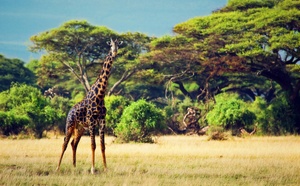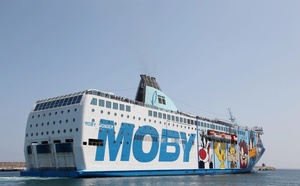Mobile internet (smartphone and tablet) accounts for close to 40% of the viewed pages in the world, and this part keeps growing to the detriment of computer connections.
In some countries, the use of the mobile far exceeds that of computers.
In France, more than half of the population connects more than once a day to Internet with a smartphone.
The uses are no longer segmented. The internet user is now multi-device and uses a computer, smartphone, and tablet all throughout the day and sometimes simultaneously.
It is thus crucial for a company to adapt to these uses in order to optimize its relation with users.
This is even more important for tourism players since the consumer utilizes all of these devices before, during, and after a trip.
We’ll make a review of the various means to optimize a company’s mobile Internet presence.
In some countries, the use of the mobile far exceeds that of computers.
In France, more than half of the population connects more than once a day to Internet with a smartphone.
The uses are no longer segmented. The internet user is now multi-device and uses a computer, smartphone, and tablet all throughout the day and sometimes simultaneously.
It is thus crucial for a company to adapt to these uses in order to optimize its relation with users.
This is even more important for tourism players since the consumer utilizes all of these devices before, during, and after a trip.
We’ll make a review of the various means to optimize a company’s mobile Internet presence.
The Website
Autres articles
-
 Raffour : "Le besoin vital de partir constitue la clef de la résilience du secteur"
Raffour : "Le besoin vital de partir constitue la clef de la résilience du secteur"
-
 Pour les OTA, la crise est déjà oubliée...
Pour les OTA, la crise est déjà oubliée...
-
 Ventes e-tourisme 2021 : +42% versus 2020, -25% versus 2019
Ventes e-tourisme 2021 : +42% versus 2020, -25% versus 2019
-
 France : les territoires ont imaginé le monde post-covid, sera-t-il si différent ?
France : les territoires ont imaginé le monde post-covid, sera-t-il si différent ?
-
 Rencontres e-tourisme de Pau : le programme sur le "monde d'après" est sorti
Rencontres e-tourisme de Pau : le programme sur le "monde d'après" est sorti
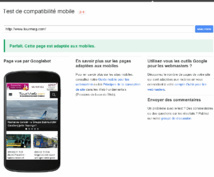
Google has put online a tool to test your website and a guide to optimize it - DR: Screenshot Google
With the amplitude that took social networks, the website remains a company’s privileged point of contact with its users.
In fact, it is the only support on which it has complete control in terms of ergonomics, design, and content.
In order to touch mobile users, you can either have a website in responsive design (that automatically adapts to the user’s device), or a mobile website (that is a dedicated version.)
These two types have their ups and downs, it thus important to see which best responds to your strategy. We will address this debate in another chronicle.
In any case, you cannot go without a mobile website. Since November 2014, Google announced that the mobile was going to become an integral part of its algorithm.
In other words, if your website is not optimized for a mobile, you’ll lose points in your natural referencing. Google has put online a tool to test your website and a guide to optimize it.
In fact, it is the only support on which it has complete control in terms of ergonomics, design, and content.
In order to touch mobile users, you can either have a website in responsive design (that automatically adapts to the user’s device), or a mobile website (that is a dedicated version.)
These two types have their ups and downs, it thus important to see which best responds to your strategy. We will address this debate in another chronicle.
In any case, you cannot go without a mobile website. Since November 2014, Google announced that the mobile was going to become an integral part of its algorithm.
In other words, if your website is not optimized for a mobile, you’ll lose points in your natural referencing. Google has put online a tool to test your website and a guide to optimize it.
The local search
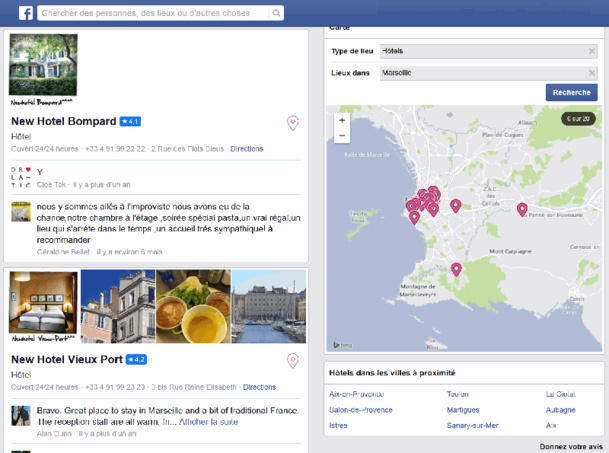
This geolocation combined with the speed of transport (by foot or in train) can become signals to provide a user with the most appropriate results. - DR: Screen Shot Facebook Places
The main web players such as Google and Facebook are basing themselves more and more on the local search to improve the information they provide to Internet and mobile users based on where they’re coming from, their habits, and especially their geolocation.
This geolocation combined with the speed of transport (by foot or in train) can become indicators to provide the most appropriate results to a user.
Your website is a great way to be better positioned on these local searches, but to optimize your presence you must combine other tools.
This geolocation combined with the speed of transport (by foot or in train) can become indicators to provide the most appropriate results to a user.
Your website is a great way to be better positioned on these local searches, but to optimize your presence you must combine other tools.
Social Networks
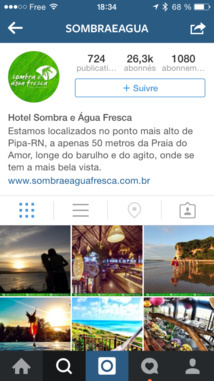
Screenshot Instagram
Social networks are the best supplement to optimize your local positioning.
They enable to combine the indicators by expanding your presence.
We had talked about social networks and geolocation in a special chronicle. The main platforms are Google+, Facebook, Instagram, Foursquare and Pinterest.
Since that chronicle, Facebook launched a dedicated website to local search. Facebook Places along with Instagram that has grown exponentially to become the second social network in the US, before Twitter.
Instagram is now one of the privileged tools of tourism players due to its simplicity of usage and its growing number of users.
It is used by institutions to put forward their regions, as well as accommodation providers, DMCs, and agencies to highlight their products and services.
They enable to combine the indicators by expanding your presence.
We had talked about social networks and geolocation in a special chronicle. The main platforms are Google+, Facebook, Instagram, Foursquare and Pinterest.
Since that chronicle, Facebook launched a dedicated website to local search. Facebook Places along with Instagram that has grown exponentially to become the second social network in the US, before Twitter.
Instagram is now one of the privileged tools of tourism players due to its simplicity of usage and its growing number of users.
It is used by institutions to put forward their regions, as well as accommodation providers, DMCs, and agencies to highlight their products and services.
Applications
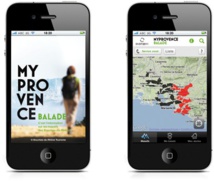
Bouches-du-Rhône Tourisme offers an application dedicated to hikes - DR : Visit Provence
Mobile applications enable to enrich the relationship with users, but that means they need to download and use your application to do so.
When we know that a mobile user only uses a quarter of the applications he has set-up, it is important to think thoroughly on the added value and return on investment.
The success of an application resides essentially on what it brings to the user. Why would I want and need to use this application?
Bouches-du-Rhône Tourisme asked itself this question in 2011 and chose to create different application depending on usage.
For example, it offers an application dedicated to hikes, one for events, and another for points of interest, and has just launched an application that agglomerates users’ great deals.
When we know that a mobile user only uses a quarter of the applications he has set-up, it is important to think thoroughly on the added value and return on investment.
The success of an application resides essentially on what it brings to the user. Why would I want and need to use this application?
Bouches-du-Rhône Tourisme asked itself this question in 2011 and chose to create different application depending on usage.
For example, it offers an application dedicated to hikes, one for events, and another for points of interest, and has just launched an application that agglomerates users’ great deals.
QR Codes
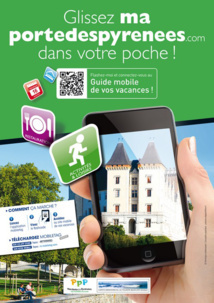
DR: Pau Tourisme
QR Codes have been around for 20 years and enable to prolong your relationship with your users.
Here also, it is very important to think thoroughly in where you’re positioning the symbol and the page to which you link to.
There are still companies that link to website that are not optimized to mobiles or that place QR codes that are too small to be scanned.
The QR Code is a great tool to provide important information to a user: downloading an app, the history of a place the tourist is visiting, information on the hotel’s attributes when he’s in the room, or a promotional video on a product as did Ecuador by placing QR Codes on bananas.
You understand, you can no longer create a digital strategy without including the mobile.
All tourism actors have understood that much but not all have managed integrating and exploiting it correctly.
Accord announced a plan of more than 225 million euros to rethink its digital strategy with the mobile at the heart of this strategy.
Accord has means that few players have, but it is possible to be creative with a small budget. It is undeniably essential to get to it because clients are already there.
Here also, it is very important to think thoroughly in where you’re positioning the symbol and the page to which you link to.
There are still companies that link to website that are not optimized to mobiles or that place QR codes that are too small to be scanned.
The QR Code is a great tool to provide important information to a user: downloading an app, the history of a place the tourist is visiting, information on the hotel’s attributes when he’s in the room, or a promotional video on a product as did Ecuador by placing QR Codes on bananas.
You understand, you can no longer create a digital strategy without including the mobile.
All tourism actors have understood that much but not all have managed integrating and exploiting it correctly.
Accord announced a plan of more than 225 million euros to rethink its digital strategy with the mobile at the heart of this strategy.
Accord has means that few players have, but it is possible to be creative with a small budget. It is undeniably essential to get to it because clients are already there.

Patrick Leimbert is a consultant in digital strategy and marketing.
After many years spent as a client and as an agent, he came back to France in 2010 and founded the company Digital Adrénaline.
He helps his clients in all of their digital challenges, from redesigning a website to setting up a social network
presence.
www.digitaladrenaline.fr :// www.digitaladrenaline.fr
After many years spent as a client and as an agent, he came back to France in 2010 and founded the company Digital Adrénaline.
He helps his clients in all of their digital challenges, from redesigning a website to setting up a social network
presence.
www.digitaladrenaline.fr :// www.digitaladrenaline.fr










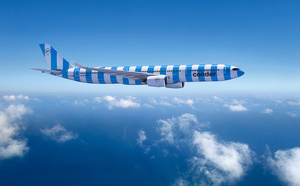



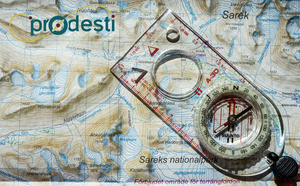





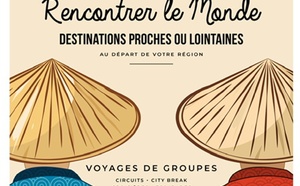
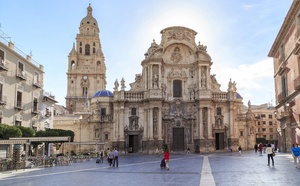
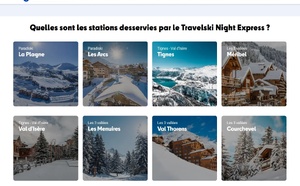



![Tourisme : où sont passés les Chinois ? [ABO] Tourisme : où sont passés les Chinois ? [ABO]](https://www.tourmag.com/photo/art/large_16_9/87929923-62307593.jpg?v=1744721842)
